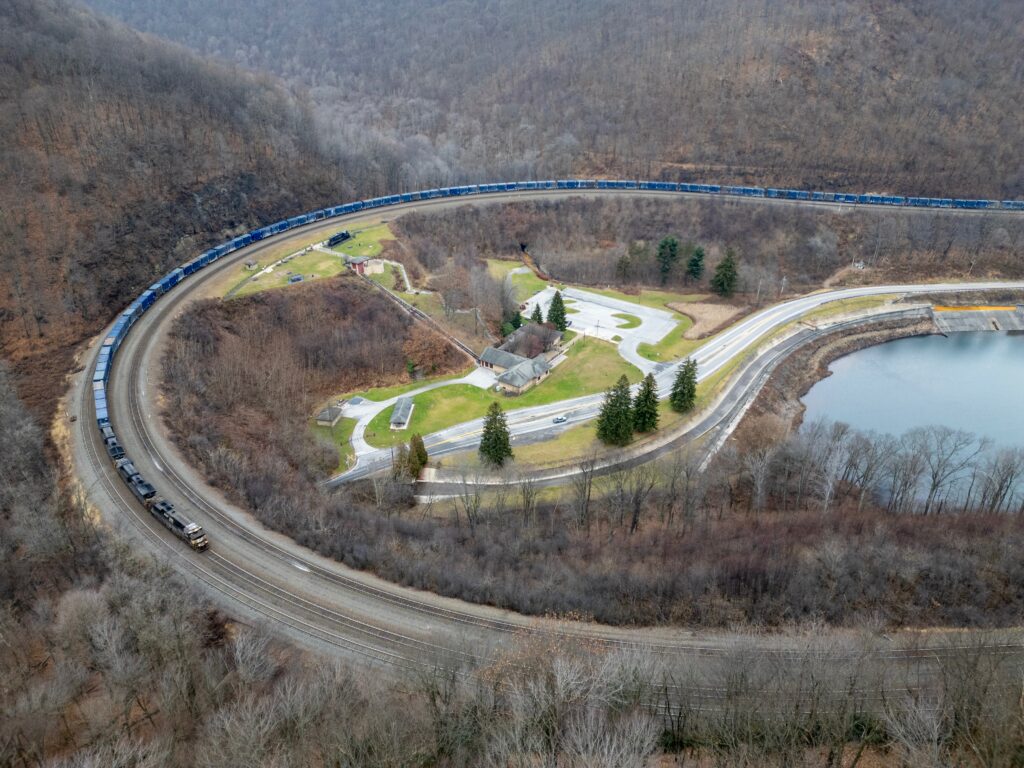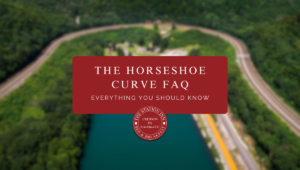Nestled in the heart of Pennsylvania’s rich railroad history, The Horseshoe Curve is more than just an engineering marvel—it’s an industry landmark and a must-visit destination for railfans and history buffs alike. From its groundbreaking construction in the mid-19th century to its pivotal role during World War II, The Curve has left an indelible mark on the local landscape and the broader narrative of American innovation.
Let’s dive into the fascinating world of The Horseshoe Curve!
Table of Contents
What is the History of The Horseshoe Curve?
What Railroad Owns The Horseshoe Curve?
Where Can I Find Horseshoe Curve Train Ride Tickets?
Where Can I Find The Horseshoe Curve Live Camera?
Where Can I Find The Horseshoe Curve Train Log?
What Is The Horseshoe Curve Train Schedule?
Where Can I Stay At The Horseshoe Curve?
What Is the History of the Horseshoe Curve?
The Horseshoe Curve is a three-track railroad curve built five miles west of Altoona, PA, and only 10 miles northeast of The Station Inn (Cresson, PA). Amazingly, this massive project (which originally had four tracks until one was removed in 1981) was built more than 1,500 feet above sea level with little more than human muscle, pick axes, and shovels over a four-year period.
When engineers first started the project in 1850, the goal was to replace the Allegheny Portage Railroad, which was a long, complex system of canals and inclined planes through the Allegheny mountains.
So, when The Horseshoe Curve finally opened in 1854, it was immediately recognized worldwide as an engineering marvel, and it quickly became a tourist attraction; the first observation park was built in 1879.
Over the years, The Curve has been entrenched in local, state, and national history. During WWII, for example, it became a major throughway for the Allied war efforts, transporting troops and supplies to the east coast for eventual shipment across the Atlantic.
The Horseshoe Curve grew so valuable, it even became a focal point for the Nazis, who tried to sabotage the US by blowing up the railway! Fortunately, their efforts were thwarted before Nazi agents could reach the Allegheny mountains.
Today, The Horseshoe Curve remains a valuable economic and cultural touchpoint. The curve itself and the Railroaders Memorial Museum are popular attractions for railfans, and the rail lines are busy with cargo, while Amtrak hauls passengers once per day in each direction between Pittsburgh, Philadelphia, and NYC.
Perhaps most importantly, The Horseshoe Curve is:
- On the National Register of Historic Places
- A National Historic Landmark
- A National Historic Civil Engineering Landmark
(Side note: The three tracks that run along The Horseshoe Curve also run in front of The Station Inn! Book a room with us to see nearly 50 trains a day!)

What Railroad Owns The Horseshoe Curve?
The Horseshoe Curve is owned by Norfolk Southern Railway.
The Curve was built by the Pennsylvania Railroad, and through mergers and acquisitions has been owned by the Pennsylvania Railroad, Penn Central Transportation Company (Penn Central), and Consolidated Rail Corporation (Conrail).
Where Can I Find Horseshoe Curve Train Ride Tickets?
Folks who visit The Horseshoe Curve frequently ask the same question: Where can I access tickets to ride along The Horseshoe Curve?
Unfortunately, the answer is heartbreaking: You can’t. Train rides aren’t offered at The Horseshoe Curve, nor can you ride along the Curve itself.
However, you can see The Curve while riding along the Amtrak Pennsylvanian, which runs every day between Pittsburgh and New York City. Here’s our recommendation: Hop on the train in Johnstown at 9:05, then get off in Altoona. Spend the day in Altoona, then grab the 5:16 train back to Johnstown!
If you’re interested in grabbing tickets on the Pennsylvanian, visit the Amtrak website.
Where Can I Find The Horseshoe Curve Live Camera?
The Horseshoe Curve live camera is a popular web destination for online railfans all over the world. If you’d like to check out The Horseshoe Curve live, watch the Horseshoe Curve webcam available on the Virtual Railfan YouTube channel:
Stay sharp! The Horseshoe Curve live stream captures close to 50 trains per day.
The Virtual Railfan YouTube channel is an excellent resource for streams from all over the country, so be sure to check out the rest of its library!
Check out additional live stream information on our live stream page!
Where Can I Find The Horseshoe Curve Train Log?
You can find a wonderful Horseshoe Curve train log on the PT 242 Train Board. There, you can track:
- Which trains have recently passed
- Which trains are coming up
- Statistics
- Notes
If you like the PT 242 Horseshoe Curve train log, be sure to follow the PT 242 Facebook page!
What Is the Horseshoe Curve Train Schedule?
A totally complete, accurate train schedule for The Horseshoe Curve is hard to come by. A few resources you can try:
- Train Aficionado created a Horseshoe Curve timetable back in 2020, but it is outdated and only good for a general framework.
- PT 242 keeps a list of upcoming trains at The Horseshoe Curve, and it also includes the probability of those trains actually passing by.
Still, there’s sometimes no telling what will pass on the tracks until you see them for yourself.
Where Can I Stay At The Horseshoe Curve?
If you’d like to visit The Horseshoe Curve and stay nearby, book a room with us at The Station Inn! The inn was built in 1866—only 12 years after the completion of The Horseshoe Curve!
In that time period, The Station Inn has become a home-away-from-home for railfans all over the country, thanks to our proximity to The Curve, the Cassandra Railroad Overlook, the Gallitzin Tunnel Park & Museum, the Allegheny Portage Railroad Museum, and plenty of other attractions right here in the heart of rail country.
And while you’re here, don’t forget to visit Horseshoe Curve Park! Horseshoe Curve Park is administered by the Railroaders’ Memorial Museum in Altoona, PA. Purchasing entry to one grants access to both locations. We are friendly with RMM and their executive director, and definitely would be remiss if we left them out of this blog post! There is a museum, gift shop, restrooms, and a “funicular” which is somewhat like an incline in Pittsburgh, which can take you up to the track level. Otherwise, you’ll need to walk up something like 150 stairs.
